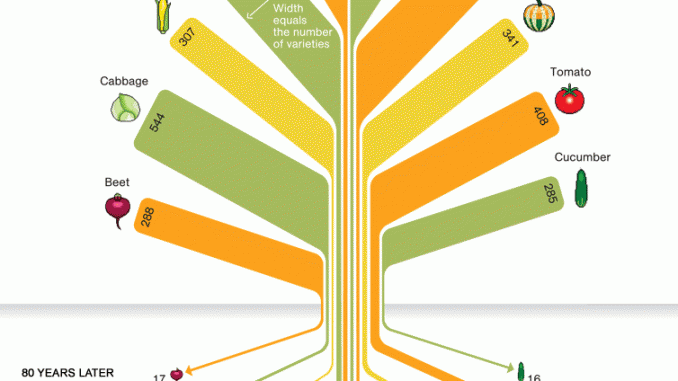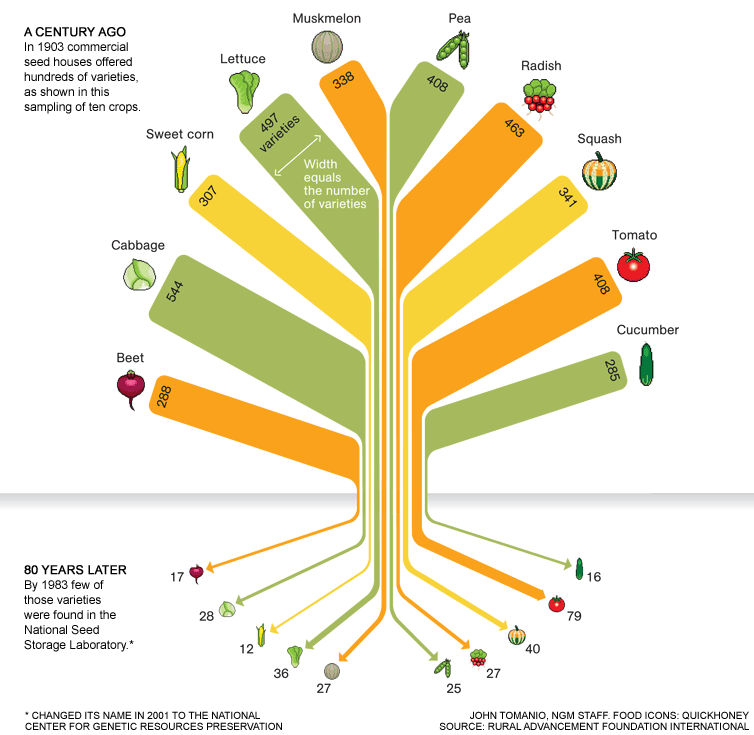
It is often discussed that we have 93% fewer food crops available today to us than we did 100 years ago. You may have also heard that much of our food diversity has either gone extinct or completely disappeared. When You examine the infographic below from a 1983 survey of the National Seed Survey Lab that was undertaken by the Plant Genetic Resources Project of the Rural Advancement Fund, you can see why many believe this fact.
From ExposingTruth.com:

BYPASS THE CENSORS
Sign up to get unfiltered news delivered straight to your inbox.
You can unsubscribe any time. By subscribing you agree to our Terms of Use
Latest Video

It isn’t hard to believe considering this since we are experiencing an extinction rate of approximately 1000x the normal background rate and have seen an average loss of 52% in over 10,300 cohorts measured since 1970. But, a more detailed examination of the facts leads us to see that the diversity of human food crops, unlike general biodiversity, has not shrunk significantly overall.
It is also an odd choice to compare all commercially available seeds from 1903 with a single laboratory (which, right now, apparently has over 9,000 types of tomatoes). You cannot compare all options available in 1903 with the holdings of a single laboratory that was only built in 1958. This is not a good metric for comparing the our food diversity.
Thankfully, a review of all available data was undertaken to see how the claim of our dwindling food diversity holds up. Researchers from the University of Illinois compared all available 1903 commercial seed catalogues with all available 2004 commercial seed catalogues. They found that older varieties had a survival rate that was twice the rate reported by Fowler and Mooney (whose work is cited in the infographic above). It is also worthy of note that the authors compared
In fact, instead of seeing a 93% loss of variety they saw overall variety change from 7218 varieties of the forty-two vegetable crops in 1903 to 6916 by 2004. If we don’t count corn in the comparison, we actually find more different species of the 42 crops today than we had before: 6739 today as compared to 6429 in 1903.
Although the authors thought they would either be able to find a diminishing diversity or a boom based on biotechnology and patents, they found neither. They found no evidence to support the thesis that we are eroding our available food supply, and no evidence that the patenting of life since 1985 has greatly increased the number of available species.
Comparing this to changes in where humans get their calories (from Khoury, Bjorkman et al, 2013) shows that although we do have as many or more choices in our food, we are getting our calories increasingly from a limited number of sources. Our diet has changed, even if we have a similar number of species available to be consumed.

We are still in a global diversity crisis with wide-reaching implications for human life on this planet, and although we have managed to preserve our sources of food we are largely failing to preserve existing ecosystems (while adding 250 trillion Joules, or approximately 4 Hiroshima bombs worth of heat, to the planet per second).
We should continue to preserve our thousands of varieties of food, we can also discuss how to more strategically incorporate GMOs (preferably open-source and independent of chemical agriculture) while learning to live more sustainably on the land.


